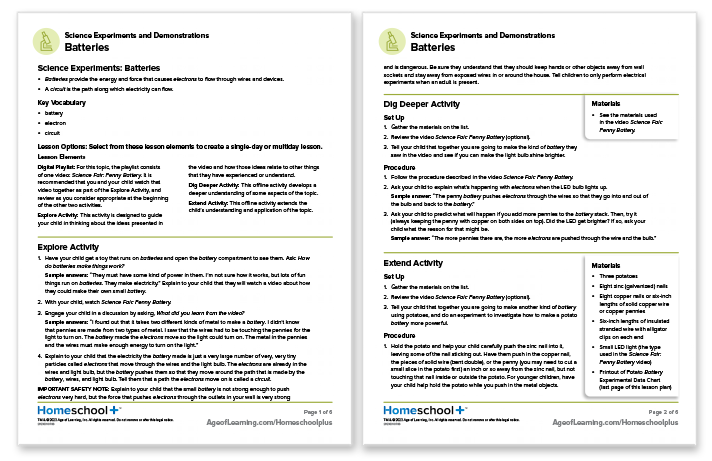COURSE
Science Experiments
Science Experiments & Demonstrations will introduce your child to concepts including:
- Electricity
- Solids, Liquids, and Gasses (States of Matter)
- Heat Temperature
- Gravity
- Simple Machines
- Objects That Float in Water and Air (Buoyancy)
COURSE OVERVIEW
This course offers an interactive, hands-on approach to learning about the science that surrounds us. Through the activities in this course, you and your child will watch and create demonstrations, test hypotheses, observe and record data, and draw their own conclusions about their findings.
By the end of the course’s 15 lessons, your child will have a deeper understanding of a range of fundamental scientific concepts, including states of matter, electric current, temperature, fluid pressure, molecules, sound waves, leverage, and others. Along the way, they will experience the process of science as an active and thoughtful exploration and investigation in search of knowledge.
LESSON 1: AIR PRESSURE
In this lesson your child will learn how gases expand and fill containers, and how the pressure exerted by these gases can be measured. Your child will also discover how the behavior of air particles can be observed and studied through different demonstrations.
LESSON 2: GRAVITY
Help your child understand the concept of gravity and how it influences the way objects move on Earth. Your child will learn how Earth’s pull and the resistance of the air determine the motion of objects in flight.
LESSON 3: LEVERAGE & LEVERS
Teach your child about the basic principle of leverage. Your child will learn how levers are used to apply force and move objects based on the principle of a fulcrum. Your child will also discover how simple machines like levers make it easier to move things.
LESSON 4: INCLINED PLANES
Introduce your child to inclined planes and their everyday uses with this lesson. Your child will learn that inclined planes are simple machines used to reduce the amount of force needed to move an object to a higher location.
LESSON 5: REACTION TIME & THE BRAIN
Teach your child about the concept of reaction time and its relationship to the senses and the brain with this lesson. Explore the amount of time it takes for signals to get from a sense receptor to the brain and from the brain to the muscles. Your child will also discover that reaction time can be measured.
LESSON 6: CENTER OF GRAVITY: BALANCING POINTS
Help your child understand that the center of gravity of an object is the point about which an object’s weight is evenly distributed, and that an object will maintain balance when supported or suspended at this point.
LESSON 7: PORTNETIAL & KINETIC ENERGY: PENDULUMS
In this lesson your child will learn that potential energy is stored energy and kinetic energy is the energy of motion. They will use a pendulum to demonstrate the conversion of potential energy to kinetic energy and vice versa.
LESSON 8: VIBRATION & PITCH: A ONE-STRING GUITAR
Help your child understand that sound is a rapid vibration that travels through air or another substance, and that pitch is the perceived highness or lowness of that sound. They will also understand the relationship between pitch and the vibration rate of musical instruments.
LESSON 9: SIMPLE MACHINES: MAKE A CATAPULT
Introduce your child to the use of levers in the construction of catapults. Your child will understand how a catapult uses a lever to launch an object at high speed by applying force in a specific way.
LESSON 10: FREEZING POINT: MAKING ICE CREAM
Get ready for some cool science! In this lesson, your child will learn that the freezing point of water can be lowered by adding salt and understand how this can be used to make ice cream.
LESSON 11: BUOYANCY: BUILDING BOATS
Explore the concept of buoyancy by helping your child understand that when an object is placed in water, the water exerts an upward force, called the buoyant force, and that this force can be changed by altering the shape of an object.
LESSON 12: HEAT & TEMPERATURE: MOLECULES IN MOTION
In this lesson, your child will learn about the concept of heat and its relationship to temperature. They will understand that heat is the motion of the molecules that things are made of, and that heat can be measured by observing the expansion of liquids.
LESSON 13: POLYMERS: MATERIALS WITH MANY USES
Stretch your child’s imagination with this lesson on polymers. Your child will learn that plastic and rubber are made of long, flexible molecules, and that these molecules give the materials their properties.
LESSON 14: INVESTIGATING WATER PRESSURE
Introduce your child to the concept of water pressure. Your child will learn that the deeper you go underwater, the more force you will feel because of the weight of the water above you.
LESSON 15: ELECTRICITY: MAKE A BATTERY
In this lesson your child will discover how batteries provide the energy that makes things like toys and flashlights come to life by pushing electrons through wires. They will also learn the concept of a circuit and how it allows electricity to flow.
